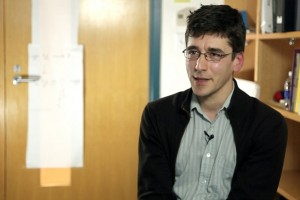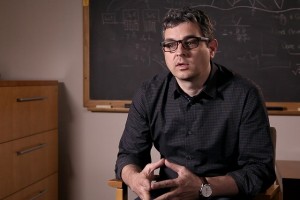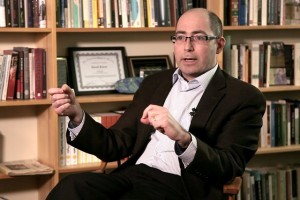Reverse Engineering in Biology
Harvard Research Scientist Leonid Peshkin on cell models, experiments in silico, and drug discovery

Thomas Kuhn’s remarkable 1962 book The Structure of Scientific Revolutions is considered the starting point of a vast interdisciplinary field in the social sciences known as Science and Technology Studies (STS).
In STS, it is widely accepted that scientists, doctors, and engineers construct their objects of study in specific ways. These objects are created from various components, and then they take on a life of their own—objects do not exist independently in nature. In this sense, in medicine, disease is considered a social construct. For STS, an important task is identifying and exploring controversies—situations where things do not go as expected, actions are duplicated, or there are contradictions. Through detailed ethnographic observations of routine practices in hospitals, laboratories, public transport, factories, schools, and other environments, such controversies often emerge. Consequently, STS research in medicine focuses on identifying these contradictions or misalignments. It also pays attention to how these inconsistencies are managed, masked, or resolved, emphasizing the importance of coordination work.
One prominent example of such research is the 2005 book Making Parents by British researcher Charis Thompson. It addresses the topic of artificial reproduction. Thompson introduces the critical concept of “ontological choreography,” which she uses to connect what she calls different ontological orders. On the one hand, artificial reproduction involves complex technologies which represent one ontological order. On the other hand, parents are able to form families or establish kinship relations between mother, father, and child. She argues that these are entirely different ontological orders: technology on one side, kinship or family happiness on the other. Ontological choreography is a term meant to illustrate how these different orders are brought together.
Another example is the book Biomedical Platforms by two American authors, Alberto Cambrosio and Peter Keating. It begins with a case in which a doctor or lab technician posts a request for help on a medical forum, explaining that two different methods for diagnosing leukemia yield contradictory results. The first method, morphological analysis, involves examining cells under a microscope, while the second, immunophenotyping, is a biochemical analysis. These two sets of data should align, but sometimes, a cell that appears normal under a microscope may indicate disease according to immunophenotyping. Identifying and addressing such discrepancies is essential in STS, particularly in the study of medicine.
Now, let me discuss another significant work, The Body Multiple: Ontology in Medical Practice, published in 2002 by Dutch philosopher and anthropologist Annemarie Mol. Mol studied atherosclerosis in a Dutch hospital, which she refers to as “Hospital Z.” Over four years, she conducted ethnographic research there, visiting several times a week to observe the interactions, conversations, and practices of hospital staff, as well as examining statistics, scientific literature, and more. Her primary aim was to understand how atherosclerosis is produced in Hospital Z. Atherosclerosis is a vascular disease in which cholesterol deposits narrow blood vessels, restricting blood flow and potentially leading to limb loss. Patients typically report symptoms like pain while walking, numbness, or a feeling of coldness in the affected area, prompting them to seek medical attention.
Mol focused on atherosclerosis of the lower limbs. At first, it seemed that different hospital departments worked toward a common goal—diagnosing and confirming or ruling out atherosclerosis based on patient complaints. Initially, a surgeon would examine a patient, perhaps palpating the affected area, and, if necessary, operate to remove part or all of a limb. However, Mol found one aspect of these procedures puzzling: the work in the pathology department.
Pathology is a discipline that seeks to understand how diseases develop. Once a limb is amputated, it is sent to the pathology department, where a doctor examines it under a microscope to confirm or refute the presence of atherosclerosis. This occurs after the surgery has already been performed, which means the pathologist’s findings validate the actions of the other specialists. But Mol raised an important question: Are there cases where atherosclerosis is not confirmed? The answer is yes, though these cases are rare. This led her to conclude that the pathology department’s work is not always aligned with the other departments’ practices. There is a disconnection between identifying atherosclerosis in the moment and in different contexts. Mol concluded that atherosclerosis is produced differently in various parts of Hospital Z.
Mol continued her investigation, using the metaphor of theater to argue that atherosclerosis is “enacted” in different ways across the hospital. Notably, the actors—medical professionals—are unaware that they are performing; to them, this is real life, not a staged production. They cannot step off the stage.
Mol asked whether it is possible to confirm or refute the presence of atherosclerosis before surgery. The answer is yes—there are two other diagnostic procedures: angiography and duplex ultrasound. Angiography involves using X-rays and a special dye to visualize blood vessels, while duplex ultrasound measures blood flow speed; high speeds indicate a narrowed vessel, while low speeds suggest no thickening. Mol asked whether there are cases where the results of angiography and duplex contradict each other. In Hospital Z, such contradictions are common. She found that, in these cases, angiography is considered the “gold standard” and takes precedence over duplex.
Mol’s central idea is that angiography is one way of enacting atherosclerosis, but it may or may not align with other methods. This illustrates how coordination work between different departments results in the production of various versions of atherosclerosis. The title of her work, *The Body Multiple*, refers to the idea of multiple atheroscleroses that are not connected.
Coordination work occurs in two ways: through additional procedures and through calibration, where different diagnostic methods are compared and aligned. Mol also questioned whether epidemiological data and statistical information on disease prevalence help in these cases. Epidemiology, in theory, should confirm or refute the presence of atherosclerosis based on factors like age, gender, weight, and even nationality. However, Mol was interested in discrepancies between individual cases and epidemiological data, noting that isolated cases continue to shape overall statistics.
In sum, Mol’s key contribution demonstrates that in hospitals, diseases are not singular entities; there are many versions of the same disease. These are not fragments of one mosaic but are each assembled or “enacted” anew every time. Mol’s work highlights the importance of recognizing these discrepancies across hospital departments, separated by long corridors and doors, where disease is produced and understood differently.
Mol’s work does not criticize the doctors or suggest that Hospital Z functions poorly—it likely operates quite well. The number of discrepancies is relatively small, and identifying them helps us understand how hospitals function and how diseases are produced within them. Mol argues that her research is political, providing an opportunity to improve hospital operations and suggesting that collaboration with anthropologists and philosophers could reduce the number of such discrepancies.

Harvard Research Scientist Leonid Peshkin on cell models, experiments in silico, and drug discovery

Biomedical Engineer Thomas Heldt on preventive patient care, patterns of disease progression, and quantifying ...

Physicist David Kaiser on measuring time delay, problems of communications during war, and governments impact ...